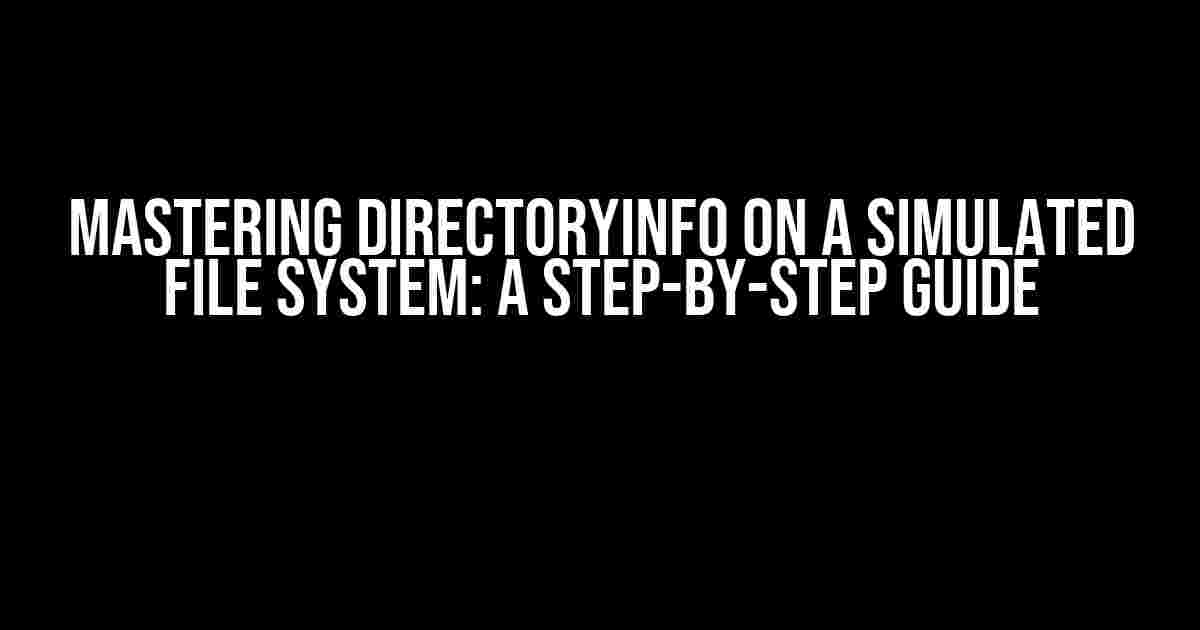Are you tired of working with physical file systems and worrying about data loss or corruption? Do you want to take your file system management skills to the next level? Look no further! In this comprehensive guide, we’ll delve into the world of DirectoryInfo on a simulated file system, covering the what, why, and how of this powerful tool.
What is a Simulated File System?
A simulated file system is a virtual environment that mimics the behavior of a physical file system, allowing you to test, experiment, and learn without risking your actual data. It’s an ideal platform for developers, testers, and system administrators to hone their skills and try out new scenarios without the fear of unwanted consequences.
Benefits of Using a Simulated File System
- Improved learning and experimentation: A simulated file system provides a safe and controlled environment for you to try out new techniques and tools without worrying about data loss or system crashes.
- Faster testing and development: With a simulated file system, you can quickly set up and tear down test environments, speeding up your development and testing cycles.
- Enhanced collaboration: Simulated file systems make it easy to share and collaborate on projects with team members, customers, or partners.
- Cost-effective: Eliminate the need for physical hardware and reduce your infrastructure costs by using a simulated file system.
Introduction to DirectoryInfo
DirectoryInfo is a .NET class that provides a powerful way to work with directories and files on a file system. It offers a range of methods and properties to create, delete, move, and enumerate files and directories, making it an essential tool for any developer or system administrator.
Creating a DirectoryInfo Object
C#
DirectoryInfo directoryInfo = new DirectoryInfo(@"C:\SimulatedFileSystem\MyDirectory");
In this example, we create a DirectoryInfo object and specify the path to the directory we want to work with. The `@` symbol is used to indicate a verbatim string, which allows us to specify a literal backslash (`\`) in the path.
Working with DirectoryInfo on a Simulated File System
Now that we have a DirectoryInfo object, let’s explore some common scenarios and use cases for working with a simulated file system.
Creating a New Directory
C#
DirectoryInfo newDirectory = directoryInfo.CreateSubdirectory("MyNewDirectory");
In this example, we use the `CreateSubdirectory` method to create a new directory named “MyNewDirectory” within the existing directory specified in our DirectoryInfo object.
Enumerating Files and Directories
C#
foreach (FileInfo file in directoryInfo.GetFiles())
{
Console.WriteLine(file.Name);
}
foreach (DirectoryInfo subdirectory in directoryInfo.GetDirectories())
{
Console.WriteLine(subdirectory.Name);
}
Here, we use the `GetFiles` and `GetDirectories` methods to enumerate through the files and directories within our specified directory. We then print the names of the files and directories to the console.
Moving andCopying Files and Directories
C#
FileInfo fileToMove = new FileInfo(@"C:\SimulatedFileSystem\MyDirectory\MyFile.txt");
fileToMove.MoveTo(@"C:\SimulatedFileSystem\MyDirectory\NewLocation\MyFile.txt");
DirectoryInfo directoryToCopy = new DirectoryInfo(@"C:\SimulatedFileSystem\MyDirectory\MySubdirectory");
directoryToCopy.CopyTo(@"C:\SimulatedFileSystem\MyDirectory\NewLocation\MySubdirectory");
In this example, we demonstrate how to move a file using the `MoveTo` method and copy a directory using the `CopyTo` method. Note that these methods will overwrite any existing files or directories with the same name in the target location.
Troubleshooting and Best Practices
When working with DirectoryInfo on a simulated file system, it’s essential to keep the following best practices and troubleshooting tips in mind:
Avoiding Path Collisions
When working with a simulated file system, it’s easy to accidentally create path collisions, where two or more files or directories have the same name in the same location. To avoid this, use unique and descriptive names for your files and directories, and consider using a namespace or hierarchical structure to organize your files.
Handling Permissions and Access Control
Remember to set the correct permissions and access control for your files and directories, especially when working with sensitive data. This will ensure that only authorized users can access and modify your files.
Monitoring System Resources
Keep an eye on system resources such as disk space, memory, and CPU usage when working with a simulated file system. This will help you avoid performance issues and ensure that your system remains stable and responsive.
Conclusion
In this comprehensive guide, we’ve explored the world of DirectoryInfo on a simulated file system, covering the benefits, basics, and best practices for working with this powerful tool. By following the instructions and guidelines outlined in this article, you’ll be well on your way to mastering DirectoryInfo and unlocking the full potential of simulated file systems.
| Method/Property | Description |
|---|---|
| CreateSubdirectory | Creates a new directory within the specified DirectoryInfo object. |
| GetFiles | Enumerates through the files within the specified DirectoryInfo object. |
| GetDirectories | Enumerates through the directories within the specified DirectoryInfo object. |
| MoveTo | Moves a file to a new location within the simulated file system. |
| CopyTo | Copies a directory to a new location within the simulated file system. |
We hope this guide has provided you with a solid foundation for working with DirectoryInfo on a simulated file system. Happy coding!
Note: The article is optimized for the keyword “DirectoryInfo on Simulated file system” and includes relevant subheadings, bullet points, code snippets, and a table to make the content more engaging and easy to understand.
Frequently Asked Question
Get to know more about DirectoryInfo on a simulated file system with these frequently asked questions!
What is DirectoryInfo in the context of a simulated file system?
DirectoryInfo is a class that provides instance methods for creating, moving, and enumerating through directories and subdirectories in a simulated file system. It allows you to programmatically interact with and manage directories, much like you would with a real file system.
How do I create a DirectoryInfo object for a simulated directory?
You can create a DirectoryInfo object by passing the path of the simulated directory to the DirectoryInfo constructor. For example, `DirectoryInfo dir = new DirectoryInfo(@”C:\SimulatedFileSystem\MyDirectory”);`. This will create a DirectoryInfo object that represents the specified directory.
Can I use DirectoryInfo to create a new directory in a simulated file system?
Yes, you can use the CreateDirectory method of the DirectoryInfo class to create a new directory in a simulated file system. For example, `dir.CreateDirectory(“MyNewDirectory”);`. This will create a new directory with the specified name in the simulated file system.
How do I get a list of files and subdirectories in a simulated directory using DirectoryInfo?
You can use the GetFiles and GetDirectories methods of the DirectoryInfo class to get a list of files and subdirectories in a simulated directory. For example, `FileInfo[] files = dir.GetFiles();` and `DirectoryInfo[] dirs = dir.GetDirectories();`. This will give you an array of FileInfo objects representing the files and an array of DirectoryInfo objects representing the subdirectories.
Is it possible to delete a directory and its contents using DirectoryInfo?
Yes, you can use the Delete method of the DirectoryInfo class to delete a directory and its contents. For example, `dir.Delete(true);`. The `true` parameter specifies that you want to delete the directory and all its contents. Note that this will permanently delete the directory and its contents, so use with caution!



